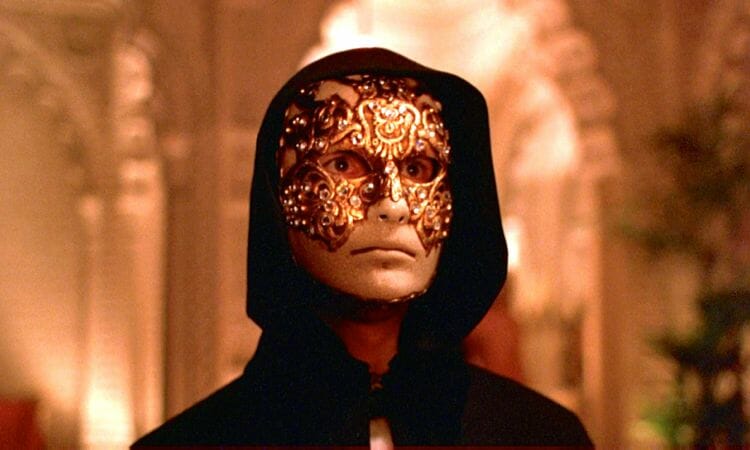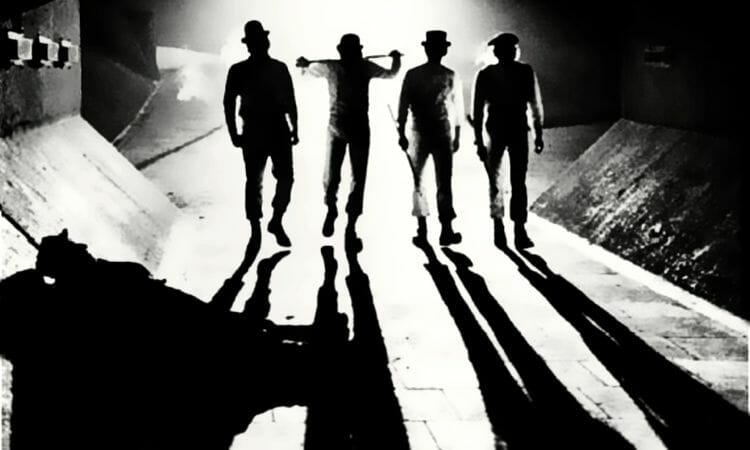By Alec Siegel · July 31, 2014


From 1971 until his death in ’99, Stanley Kubrick directed, wrote and produced five films. A meticulous researcher and perfectionist in pre-production, on set and even after his films were released (he’s been known to deliver last minute notes to distributors instructing them to cut certain scenes), Kubrick clearly spent time on these five films, the finest run of his career, and probably the finest consecutive five films of any director, ever. All have elements of different genres, but all are unmistakably Kubrick, thus hard to fit into neat boxes labeled “sci-fi," “horror” or “war." All deal heavily with the human psyche. They’re oftentimes uncomfortable films that hold a revealing lens on decisions and why we make them and broader flaws of the human condition. Beginning with A Clockwork Orange, Kubrick’s post-2001 career cemented his status as a true auteur, and established his spot at the top of film’s most accomplished artists.
After making his sci-fi epic 2001: A Space Odyssey, Kubrick expressed his desire to return to Earth for his next effort. He aimed to shoot on a significantly lower budget, yet work with equally as thought provoking material. And so he was recommended a novel by screenwriter Terry Southern (Dr. Strangelove, Easy Rider). The novel was called A Clockwork Orange, written by Englishman Anthony Burgess. Kubrick was captivated by its themes of free will and law and order, and so decided to adapt it into a screenplay. Malcolm McDowell plays the protagonist (his own antagonist as well perhaps), Alex, a vaudeville inspired teen with anarchic tendencies and an almost childlike will to follow his inhibitions, no matter how devilish they may be.

Alex is as complex and charismatic a main character as Kubrick has ever written, and the way Kubrick fleshes him out is one of the film’s strongest qualities. He’s the “humble narrator” of the story, narration being a technique Kubrick often utilizes, speaking a dialect called Nadsat, a sort of medley of Russian slang and British English. He’s perverse. He’s funny. He’s charming and he’s manipulative. His icy blue eyes are piercing and disarming. The story runs through Alex and his impulsive behavior, and he anchors nearly every scene he’s in. A Clockwork Orange is often noted as a violent, disturbing film. Which, it is. But it also stands out in Kubrick’s already exceptional filmography as one of his finest, a powerful film full of ideas and emotion.

For his next project, Kubrick eyed telling the sweeping tale of Napoleon Bonaparte. He studied copious amounts of detail in preparation: Napoleon’s personal diaries, outsider observations of the man, and details regarding the culture of Europe at the time of Napoleon’s reign. Due to the commercial failure of another Napoleon inspired picture released around the same time as Kubrick’s planned feature, his version was scrapped, and so work began on his next film, Barry Lyndon, which hit box offices in 1975. The film received mixed reviews at the time of its release, but would later be viewed as one of Kubrick’s best, even landing on many critics’ lists of the finest films in all of cinema.
The film is less about the title character’s journey as it is about his character. His circumstances are at times unlikely and absurd, and we see, though we’re also told through heavy voiceover narration from an unseen man, his character fall and rise and fall again. Redmond Barry (later fashioned as Barry Lyndon, played by American Ryan O’Neal) is a young Irish lad blinded by love at the beginning of the film, but a hardened war veteran and selfish opportunist by the end. The film is three long hours of his wanderings. First as a rogue, then as a solider, then a lord and so on.
Watching Barry Lyndon is like diving into an 18th century European painting and exploring the set and characters within the frame. Each scene, especially the card playing ones, where ladies and lads are bunched together with ornate chandeliers and flickering candles, is so detailed and atmospheric that the film feels almost like a play. The costumes, traditional 18th century English garb, are gorgeous, as are the rolling green hills of Ireland (where the film was entirely shot) and the lavish lordly manors with their pools and parlors. The score is equally as elegant. Kubrick’s films often feature classical music scored scenes that are set in space or an anarchic future. Barry Lyndon allows Kubrick a most natural setting for a classical score to flourish. Kubrick would follow this pretty period piece with 1980’s The Shining, which paired the versatile director with an equally versatile performer in Jack Nicholas.

While Barry Lyndon was showered with awards and critical acclaim, it was regarded as a snooze fest for a majority of the ticket buying audience. It was too long and too slow. So five years later, in 1980, Kubrick returned with The Shining, a fast paced thrill ride based off the Steven King novel of the same name. It guaranteed sleepless nights for those who fell asleep during Barry Lyndon. For those who still haven’t seen the film (shame on you), it follows Jack Torrance (Jack Nicholson) and his wife and son as they look after an isolated Colorado hotel during the off months. Imagine three people living in a spacious hotel for months in the middle of a Colorado winter with no outside interaction. Add in the fact that the hotel sits on an Indian burial site and was also host to a murder just years prior, and you’ve got one hell of a ghost story.
The Shining is one of the most disturbing films you’ll ever see for a couple of reasons. First, Kubrick’s unique vision for unsettling imagery is at a peak here. He expresses the dual feelings of spacious isolation and cramped claustrophobia felt by the film’s characters perfectly. His ability to remain inventive and unapologetically Kubrick within the accepted confines of the horror genre is astonishing. He’s as versatile a director as there is. A shrill score that features nails on chalkboard-esque unease and sudden shifts in tone heighten the psychological discomfort already brought upon by Kubrick’s images. The performances are all workman like compared to Nicholson’s dynamic and, at times, comically disturbed portrayal of Jack. His little boy Danny, who is able to “shine”, an ability that allows him to have vague impressions of the future and vivid feelings of the past (no matter how disturbing), is as creepy as little children in horror films can be. The Shining is horrifying for its supernatural undertones and its unsettling images. Full Metal Jacket, Kubrick’s follow up, is equally as horrifying, with its ultra realistic and intimate portrayal of the Vietnam War.

Kubrick’s films are far from formulaic, and usually do away with the traditional three act structure. Full Metal Jacket (1987) is Kubrick’s Vietnam War film, and essentially tells two stories with a few overarching characters to guide us. The first half takes place at Parris Island, a training base for the Marine Corps, as the new recruits are given nicknames-Joker, Snowball, Pyle, Cowboy-and are berated by their drill instructor (R. Lee Ermey, an actual drill instructor who ad-libbed much of his dialogue, including the crude insults) and endure the physical and emotional hell of boot camp. Kubrick’s knack for pairing striking images with off-kilter music is jarring.
The film opens with pouty-faced recruits getting their heads shaven, the first step in becoming “killing machines." The scene is set to the tune of Johnnie Wright’s “Hello Vietnam," a 1965 chart topper that actually supported the war. After 45 minutes of screen time, the story jumps from one hell to another: the battlefield. The recruits have grown their hair back and regain a sense of individuality, namely Private Joker, the film’s narrator and only semblance of a protagonist. He’s not as simple as the other “killing machines." “Born to Kill” is painted on his helmet and a peace sign is pinned to his lapel. Joker, now a military journalist, represents the “duality of man." The film’s second half takes place during the Tet Offensive in Hue, Vietnam. There are no cliché, drawn out battles here. Instead, Kubrick finesses the horrors of battle and the realities of American soldiers living in a war zone.
As he did with horror and The Shining, Kubrick manipulates the characteristics of a war film and adds in deeply psychological undertones and his technical acuity to make it all his own. Full Metal Jacket is an all-encompassing take on war. We see boot camp. We see a soldier unload a magazine of bullets into the enemy. We see prostitutes offer “sucky sucky” to American G.I.s. The performances are wonderful throughout, from Vincent D’Onofrio’s “section 8” Pvt. Pyle to R. Lee Ermey’s hilarious, poison tongued drill sergeant. It’s one of the most realistic and affecting war films of all time, and would be Kubrick’s last until 1999, when his final film before his death, Eyes Wide Shut, would be released.

At age 70, for his final contribution to cinema, Kubrick made an erotic thriller. Well, that’s what it’s traditionally classified as. As with all other Kubrick films however, its too complex to easily fit into a genre. Starring then married couple Tom Cruise and Nicole Kidman, Eyes Wide Shut is a bizarre film full of sexual allegory and eroticism. It explores infidelity and marriage, sexual freedom, lust, and other wide-ranging questions. Nearly three hours long, the film is his most expository, but still rife with his typically intense images. Also unlike many of his other films, Eyes Wide Shut sort of has a plot, and that plot sort of has a conclusion. Dr. Harford (whose name is an amalgamation of Harrison Ford because Kubrick saw him as a Ford type of character), played by Cruise, is a wholly confident, lustful man tied down by his marriage to his wife Alice (Kidman), who also exhibits the urge to break free from her one partner life of Christmas shopping and extravagant parties.
The film had been in development since the mid-60s, when Kubrick flirted with the idea of creating a film about sexual relations. He had come across Arthur Schnitzel’s Dream Story at that time, and decided it would be the perfect novel to use as source material. The idea got pushed to the backburner, I guess to make way for his deluge of masterpieces to come, and finally came to light in 1999. Set in New York but mostly shot in Britain, the film gives the feeling that cities are human zoos and we’re all sexual creatures at our core, just waiting for an excuse to succumb to our most carnal vices. Don’t watch this one with your mom, but do watch it. It’s borderline pornographic at times, but fascinating inside and out.
It’s a bit late and seems a bit dramatic to eulogize Kubrick for the conclusion of this series. So I’ll end it with something that Dick Hallorann, a character in The Shining said: “Places are like people: some shine and some don’t.” Kubrick’s glow still permeates cinema today, and his artistic achievement’s behind the camera have influenced nearly every movie since he picked one up.